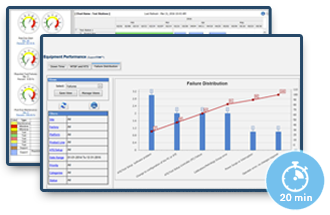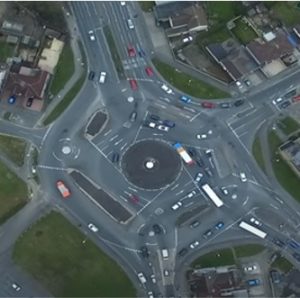

The mistake so many people make when installing solutions in their business is not to consider whether the environment is ordered versus complex. In ordered environments, cause and effect can be understood with varying levels of skill. If the environment is complex, the ordered or simple solutions that often seek to “control” will never scale to a complex environment and work as intended. In asset management solutions, the telltale signs an ordered solution is mismatched with a complex environment are things like data inaccuracy and hoarding. Both of which are extremely costly to speed and competitiveness.
When is a System Complex?
A complex system is one that has “a great many independent agents interacting with each other in a great many ways,” according to Mitchell Waldrop, a Ph.D. physicist who wrote this in “Complexity” in 1992. He said, “the very richness of these interactions allows the system as a whole to undergo spontaneous self-organization.” Ten years later David Snowden, an IBM employee with an academic background in philosophy, was researching the importance of storytelling and founded the IBM Cynefin Center for Organizational Complexity.” He invented the “Cynefin Sense-Making Framework” and today is a world-renowned consultant and author, working and speaking at the highest levels of business and government. He says at its root Cynefin, Welch for habitat, is all about proactive sense-making or meaning-making.
Danger Ahead: Simple Solution Scaled to Complex Environment
Simple solutions can not cope effectively with the different behaviors that can emerge or that are trigger when they are used in a complex environment. The initial triggering leads to a cascading set of new situations that are equally unpredictable and often compound the problem the solution was designed to help in the first place.
Imagine a high traffic intersection where seven roads intersect at one point, like spokes on a wheel. This is obviously a much different situation than a simple crossroads where traffic lights are often used effectively. It is hopefully clear scaling the simple traffic light solution to the larger and more complex environment described is fraught with dangers. One bad actor, one mistake, and the cascading set of repercussions can be enormous. Accidents. GridLock. Delays. Frustration. The hidden minefield is triggered. Instead, a different solution to this problem, the Magic Roundabout in Swindon, UK, creates order out of complexity by establishing a set of constraints (the various elements of the roundabout) along with some simple rules, ethics, or values that allows to solution to work simply, easily, fast. It is a very elegant solution to a very complex problem.

Knowing Why Something Works is Key to Success!
In one of David Snowden’s talks he said, “If you don’t understand why something works, you can’t scale what you did the last time.” This means understanding the principles, laws, and mechanisms that have been evolved and improved over time to anticipate and designed to produce situations. For business, this includes knowledge of business constitution, philosophies, ethics, identities, and organization design to name a few; Economics is the study of how people behave in complex economic situations, including whole economies, companies, or individuals. Most of what I’ve studied in these areas I’ve studied as a student of Toby Hecht, a business philosopher, accomplished business person, founder of The Aji Network, and author of Aji, An IR#4 Business Philosophy. His insights and the knowledge he teaches are as radical as Snowden’s and highly effective and valuable for those who learn them.
Knowledge of Powerful Business Philosophy and Economic Principles are Key to Design
People often think philosophy is airy-fairy nonsense without realizing what they think is based on their philosophy of life or business. If they think in a Cartesian framework they’ll think the world is objective and knowable and that a business is a machine and every person in that business is a “cog” in the wheel performing processes and procedures over and over again. People who think in this framework will think about “controlling” behavior with force rather than governing it. They “re-engineer” because that’s what you do with a machine and all its cogs. In this framework “top-down” edicts and force should work, right? But they don’t.
When we think about business as a human endeavor with people capable of agency rather than as simple cogs in the wheel we invent vastly different solutions. Principles help us anticipate behaviors in complex systems. Economic principles, for instance, help us anticipate the behaviors of actors in an economy, including in individual businesses that participate in an economy. Greg Manikew, a Harvard economist, has published Ten Principles of Economics in his book, Principles of Economics. Several have been particularly useful to the design of our solutions.
- The cost of something is what you give up to get it.
- Rational people think on the margin
- People respond to incentives
To use these principles for design it’s important to know what a cost is, what it means to be on the margin and what incentives are, and how you produce them. The answers are not as obvious as they would seem. This knowledge is core to our design and something learned from The Aji Network.
Another one of Mankiw’s Principles, “Governments can sometimes improve market outcomes,” applies in a somewhat different context than the way he’s intended. Just as with nations, governance is also important in business. How about, “Governance” can improve business outcomes. Of course, again one needs to know what governance, its meaning, relevance, value, and purposes are before you can design it effectively. Governance is a key component of Sente’s solutions in complex environments.
Sente’s Key Asset Management Capabilities for Complex Environments
We describe our asset management solutions and “Human Focused, Technology Enabled.” We’ve spoken and written extensively about how human behaviors affect the cost of capital structures in businesses. Our blog contains many examples like That One Bad Habit That Costs You Millions and Asset Management Success Factors: It’s the Humans Stupid! Only when you take human behavioral dynamics into account in the design of an asset management solution can you produce breakthrough results. Most often asset management teams feel “left out” because their solutions often cause delays and costs that people want to avoid, so they avoid those costs but add others.
Human-Centered, Technology-Enabled Asset Management
To our knowledge, no one else approaches asset management the way we do or produces the significant results we help our customers produce. What truly differentiates our asset management solutions are the three capabilities written about below. The first two capabilities listed is what makes us “Human-Centered” while the second two capabilities support the first and make our solution “Technology-Enabled.
Integrated Software CONNECTS team members with different functional or departmental requirements to coordinate and collaborate with other cross-functional team members to fulfill their individual and team roles at the lowest cost possible and accelerating team results.
Contextual Date POWERS team members to make faster and better decisions working as a team by having the data they need available in the workflows they use, where and when they use it. Knowledge like equipment capability, availability, health, history of use, and demand help team members understand the risks to their schedules and act proactively to plan and execute contingencies so they can maintain speed.
The “Sente Way” Approach ACCELERATES at the outcomes they are after — like speed and competitiveness — by identifying and eliminating the sources of organizational friction that show them down and wear them out. Our knowledge of likely emergent behavior, whether good or bad, has built substantially over the years. We know how to respond effectively to each of the emergent behaviors we’ve encountered because we know what the emergence means and how to handle it the best way. Because we know many of the most common behaviors to anticipate, we use technology to quickly identify them and damp or amplify them using our Accountability Algorithms. In complex human systems, knowledge of and skill producing trust is critical. There are many different practices we use to produce trust. Establishing governance structures is one of the key enablers of our solution that produces trust across multiple levels of your organization.
Request a Demo

See how Scireo aEAM Software drops asset and support costs by 50% while accelerating time-to-market 2X.
Relevant Content
Are Your Teams Equipped For Speed? Accelerate With aEAM Algorithms.
We are in a new age of competition that the World Economic Forum calls the 4th Industrial Revolution. New tools and technologies are enabling people to fulfill new and more competitive intentions ramping competitive pressures on everyone to move with speed and efficiency or risk failure. Incremental changes won’t work. They simply won’t be enough…
Are Your Metrics Complete? Do They Trigger Effective Behaviors and Results?
Asset Management Metrics are very important to success. I won’t say the most important though, because a number without a narrative that gives it meaning, relevance, and value might as well not exist. It won’t produce any change in direction or focus. If you don’t have a purpose, by definition they aren’t complete They are…
Case Study: Aerospace Company Drives One Company Synergies
Like many aerospace companies, this one had many sites and different legacy cultures on each. See how they installed common resource management tools, increased utilization 3X and funded new programs.
Equipment Utilization Case Study: Space Company Leverages Assets
The hoarding culture was slowing this company down while impacting cost and quality. See how a journey to common processes and collaboration lead to a 50% reduction in assets as their business doubled.
Notable Quotes
“Sente’s proprietary Test Resource Management™ solution delivers an integrated and holistic approach for test resource management with unique capabilities that allow large organizations in the aerospace and defense, semiconductors, and life sciences industries to manage and streamline the complexity of their test operations and to be more effective.”
Frost and Sullivan Analyst









